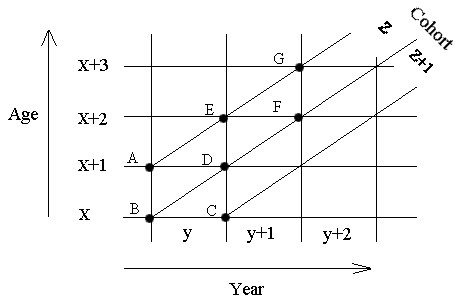The database has been constructed from data on deaths arranged into cohort survival histories. This procedure can be illustrated with a Lexis diagram (Figure 1) where age is on the vertical and time on the horizontal scale. Each person can be understood to advance diagonally in the up-and-right direction, crossing horizontal lines (birthdays) and vertical New Year days but remaining in his/her cohort (determined by the year of birth) until his/her individual line ends in death.
The vital statistics annually published by national offices customarily give the number of deaths in year y at each age x (age last birthday): square ABCD in the diagram. Many countries - fortunately for our purpose - also divide the deaths according to the year of birth, thus giving them separately for the triangles ABD and BCD. This information allows the construction of the mortality history of a cohort from deaths in successive triangles (ABD, ADE, DEF, EFG etc.) and it has been available for Belgium, Czechoslovakia, Denmark, Finland, France, Germany (West), Hungary, Iceland, Italy, Japan, Netherlands, Norway (until 1976), Poland, Spain, Sweden and Switzerland.
For countries which do not indicate the year of birth, the deaths in a Lexis square have been split into the two triangles at an arbitrary ratio. Data from countries with full information show that the ratio at old ages is, on the average, close to an even 50/50 split unless an unusual event has occurred or the numbers are small. For some countries in the database the split was made at a ratio observed in a neighbouring country but in most cases the 50/50 ratio was used. This can be considered adequate for period analysis but not for cohort analysis because it ignores the often unequal size of adjacent cohorts which may reflect short-term fluctuations in birth rate in the past.
VINCENT concluded (1951) that when a cohort has died out, its size in any past year and age can be obtained by summing up the deaths beginning with the oldest. International migration is at old age small enough to be ignored. Subsequently his " method of extinct generations" has been used by many researchers to study mortality at ages 80 or 85 years and higher, and the accuracy of the method at these ages has been generally recognized. This age limitation may be more strict than what is necessary. This author demonstrated (1990) by simulation that it can be successfully applied even to province data from age 65 or 55.
|
| Figure 1. Lexis diagram with age (x), |
| year (y) and cohort (z). |
We have applied this method in the database even for countries in which highly accurate population registers produce data on population by age and sex; in these cases the two sets of exposed-to-risk are almost identical and though the register figure may be more correct, the cumulated figure is more practical because of its consistency with data on deaths.
For cohorts which are not yet extinct, the number of current survivors has to be determined (see Chapter 4) before the deaths are summed up.
The decision to build the database on cohort histories was not motivated by a belief that cohort is the decisive or even an important factor in mortality. The main reason was that probabilities of death can be calculated most accurately when a closed group of persons is followed from one exact age to the next, and accuracy becomes increasingly important when the numbers are small as they are at the oldest ages. The cohort structure is also practical in the management and periodic updating of the files. The Odense database can be used equally well to study period mortality as cohort mortality - the latter, however, accurately only for the 16 countries listed above which have provided data by year of birth.
The present study deals with time series and therefore does not use probabilities of death (qx) but central death rates (mx)as is customary in studies of age-specific mortality over time.
